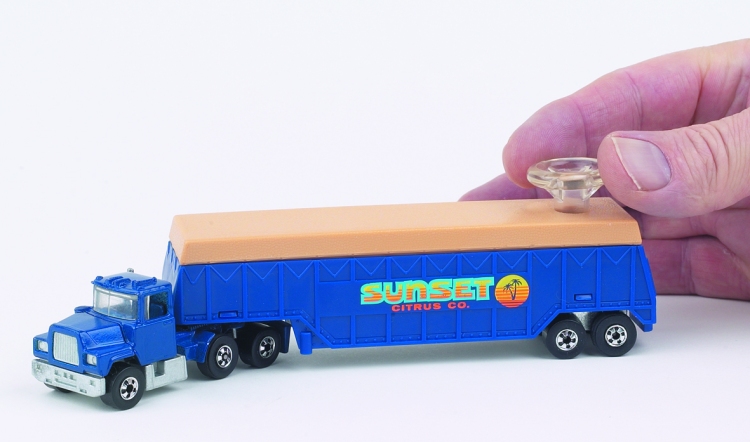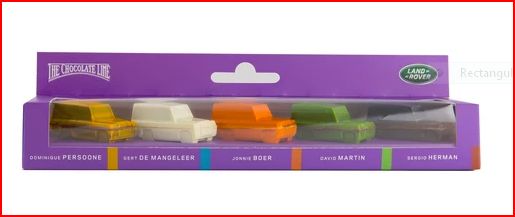Mike Pigott looks at this rare and little-known range of futuristic trucks made by Mattel’s Italian subsidiary, Mebetoys.

The Mebetoys company was set up in 1959 by the Besana brothers in a small town near Milan. Initially they manufactured toy guns and miniature household appliances, but in 1966 they began producing diecast model cars. The model cars were in 1/43, and were quite good quality, competing in the market with similar items from Mercury and Politoys (later Polistil). By 1969 there were around 40 models in the range, mostly Italian sports and saloon cars, but with some international cars in the line too.
In 1969 Mebetoys was acquired by major American toy company Mattel, probably as a way of getting a foot into the European Common Market. The Mebetoys company was renamed Mattel SpA, although in Europe the products were still sold under the Mebetoys brand until 1980. As could be expected, Mattel made changes to the Mebetoys line. The cars were fitted with plastic wheels and low-friction axles, and were painted in bright metallic colours, while American style hot rods and custom cars were introduced. There was even a range of 1/43 plastic track and accessories to race the models on. The American Hot Wheels line was sold in Italy in Mebetoys packaging. They were issued in cardboard picture boxes, similar to Matchbox toys.
The Besana brothers left the company and a few years later set up Martoys, later re-named Bburago, to produce budget-priced diecast cars in 1/43 and 1/25 scales.
Mattel began importing the new-look Mebetoys cars to the USA, where they were sold as Hot Wheels Gran Toros. Although well regarded by collectors, the Gran Toros line did not sell well in the USA, and when the diecast toy market slumped in 1972, the range was dropped. Mebetoys continued to be manufactured in Italy, but the quality dropped as models were produced with plastic bases and cheap speedwheels. Later, a range of sparsely detailed 1/25 vehicles was added.
MOTORIZED TRUCKS
In the 1979 Mebetoys catalogue, a new range of diecast model trucks were announced, although the illustrations were ‘artist impressions’, so the trucks were clearly only at the prototype stage. There were six vehicles in the range, three rigid trucks and three articulated semi-trailers.
Continue reading “Mattel – Mebetoys Trucks”





 Although best known for large-scale electric trains, the venerable American company Lionel also ventured into diecast metal train models during the 1990s. This range of six famous locomotives was produced in the once-popular 1/120 scale, or TT gauge.
Although best known for large-scale electric trains, the venerable American company Lionel also ventured into diecast metal train models during the 1990s. This range of six famous locomotives was produced in the once-popular 1/120 scale, or TT gauge.
 One of the most famous retailers in New South Wales, Australia, during the 20th Century was the department store chain of Grace Brothers. The first store was established by English immigrants Albert and Joseph Grace in 1885. Their business proved a success, and by 1906 they were able to open a massive five-story building in central Sydney. Grace Brothers was one of the first retailers to open a chain of suburban outlets, starting in 1933. Throughout the ‘50s and ‘60s they continued opening branches in the suburbs of Sydney, and in regional towns in New South Wales. In 1983, the company was taken over by Melbourne-based department store Myer. They continued trading under the Grace Bros name until 2004 when, sadly, the venerable name was phased out in favour of Myer branding.
One of the most famous retailers in New South Wales, Australia, during the 20th Century was the department store chain of Grace Brothers. The first store was established by English immigrants Albert and Joseph Grace in 1885. Their business proved a success, and by 1906 they were able to open a massive five-story building in central Sydney. Grace Brothers was one of the first retailers to open a chain of suburban outlets, starting in 1933. Throughout the ‘50s and ‘60s they continued opening branches in the suburbs of Sydney, and in regional towns in New South Wales. In 1983, the company was taken over by Melbourne-based department store Myer. They continued trading under the Grace Bros name until 2004 when, sadly, the venerable name was phased out in favour of Myer branding. Aoshima is a long-established and very well respected hobby firm from Japan. The company was formed in 1929 in Shizuoka City, and initially manufactured wooden aeroplane kits. In 1961 they began producing plastic construction kits, which soon became the main product line. There was a wide range of kits, including cars, ships, planes and military subjects, plus a number of licensed character kits based on Japanese TV shows and movies.
Aoshima is a long-established and very well respected hobby firm from Japan. The company was formed in 1929 in Shizuoka City, and initially manufactured wooden aeroplane kits. In 1961 they began producing plastic construction kits, which soon became the main product line. There was a wide range of kits, including cars, ships, planes and military subjects, plus a number of licensed character kits based on Japanese TV shows and movies.
